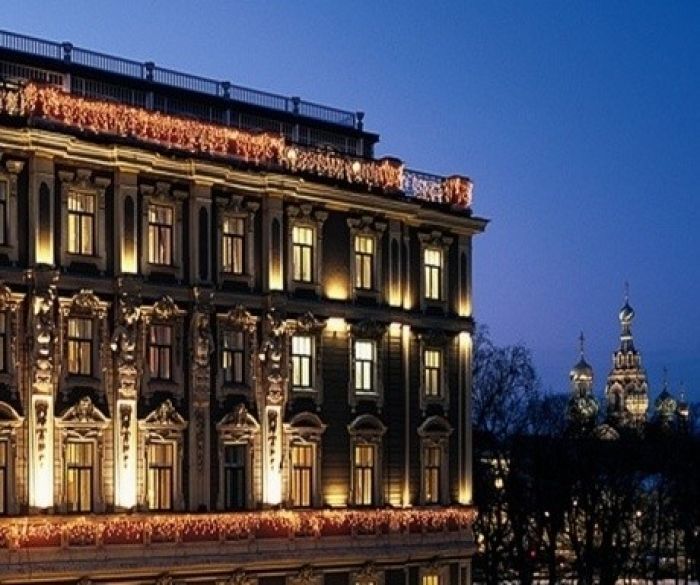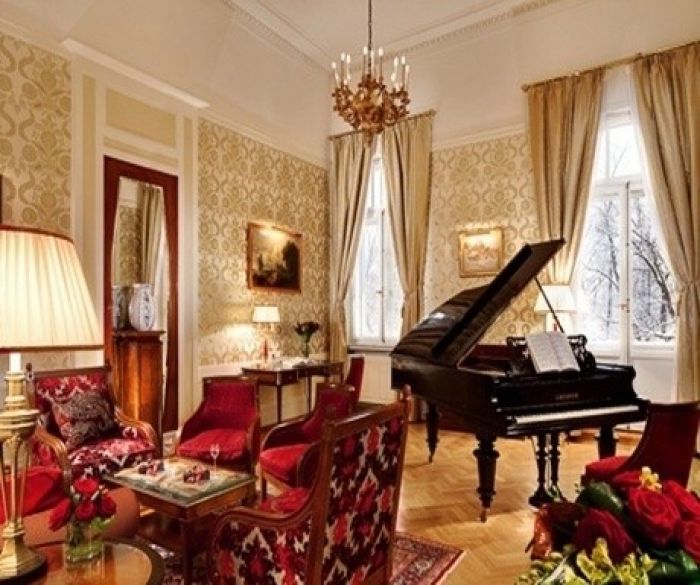
The cold was abrupt and biting as we disembarked the Moscow train. It was 10.30am in Saturday’s St Petersburg, and loud, nationalistic fanfares blared out through metallic speakers at the station. Wrapped in cashmere sweaters, suede boots and thick, bright scarves, we marched out into the dry, cold weekend.St Petersburg, Peter the Great’s ‘Venice of the north’, was founded in 1703, creating a sycophantic seaport for the Tsar – keen to foster relations with much-admired maritime nations. Built by legions of conscripted peasants (significant, in the beleaguered narrative which followed), the city soon became the aristocratic playground of the grand high families of Imperial Russia. Grandeur, elegance and imposing social dominance fuel the 18th and the 19th century architecture which lines the River Neva, and her series of interconnecting canals winding slowly into the heart of this city.For decades Tsars and their families held court in St Petersburg, generating decades of isolation from the mass of Muscovite urbanites. St Petersburg was dazzling, romantic; overwhelming; patronizing the darlings of the arts and the stage. The bright, the beautiful and the elite would glitter at balls, the ballet and behind ornately closed doors. History soon came knocking, with war, bloodshed and Bolsheviks. The Winter Palace stormed, Tsar Nikolai arrested, abdicated, executed.The rise and fall of this city is everywhere. Historic portraits hang riddled with bullets and bayonet splices. The once opulent Millionaya Street is tatty and boarded up, its absurd collonades now housing haphazard Italian eateries and forlorn “For Sale” signs. Yes, there are glimpses of modernization here, with the city’s artisan youth pushing a Scandic fusion of food and design. However, whilst its neo-classical counterparts (Stockholm, Vienna, Rome, Paris) have had the luxury of time and evolution, St Petersburg has aged with a nostalgic sadness.The city remains Russian at its core. We were an anomaly in a sea of domestic tourists battling against the cold and the wind. It’s an evocative place, and no base more so – than the Grand Hotel Europe.
Over the years, the Grand Hotel has borne witness to the seismic shifts in Russia’s political constitution. Opening in 1875, the hotel soon became a darling of the aristocracy, and a haven for visiting artists, writers, musicians and passing dignitaries. Tchaikovsky honeymooned here. Rasputin dined here. Stalin seethed about its existence. Originally designed by St Petersburg’s ubiquitous architect, Carlo Rossi, over the decades that followed, the interiors and exteriors of the hotel were updated by architects ‘du jour’, inspiring and defining the fashions of the zeitgeist. Their work would be replicated in households all over the city.And then came the revolution. In 1918 the hotel was declared a home for the Soviet clerks – the proletarian masses, who set up camp in the rooms, the ballroom and the restaurants, surrounded by the vestiges of the hotel’s former glamour. Turned into an orphanage in the 20s, the hotel was re-opened during the 1930s for the enjoyment of Soviet scions (when it became known as the natty “Hotel Evropeiskaya”), before the country descended into war once again. Over the course of the Second World War and the onslaught of the German army, the hotel was transformed into a field hospital, as the bombs fell all around.Situated on the exclusive Nevy Prospect, adjacent to the Russian Museum, and proximate to the Hermitage, the Grand Hotel has been forced to mature in an era very different from that of its origins. Re-opened in 1989, following extensive refurbishment, the Belmond Group (of former Orient Express fame), have breathed life into this hotel and have artfully reconstructed her heritage.
Far from boutique, this is a grand and elegant establishment, boasting 275 rooms, each offering a glimpse into the hotel's ethos and survival. With 10 historic suites whetting a historical appetite and brand from the Dostoevesky to the Fabergé – each suite tells a familiar story of the city and its history, personalities and struggles. The Romanov family reunite here annually, (information highly deserving of an awe-struck gasp). The Pavarotti Suite was as good as it sounds. With a balcony fit for the maestro overlooking the classical square behind, with the acoustic triumph of double height ceilings and velvet furnishings. A Baby Grand stands nonchalantly in the corner.The terrace rooms come highly recommended, with large open rooftops overlooking the city, her chimneys and surrounds. I could spend long summer months here. The promise of St Petersburg’s summer season, and her White Nights Festival burns bright. This is where the moonlight floods the sky.Breakfast, brunch and champagne lunches are served in the L’Europe dining room under a brilliantly gaudy art nouveau roof, and with a classical pianist high up on the old stage, her red sequined stilettos twinkling. Elton John famously gave an impromptu concert here, when he was passing through during the last gasps of perestroika. In the dark corners of the room you can see the sweeping curtains designed to conceal members of the Imperial family, and now prominent businessmen, demanding privacy whilst they dine.This hotel bears stories at every turn. As does this city. With just 48 hours in St Petersburg, we stomped out into the biting cold winds, and marched along the river, over the Palace Bridge, and through the Peter and Paul Fortress. We spent hours lost in the Hermitage, and gazing up at the Winter Palace (over the ice), whilst ambling alongside canals. We watched ballet at the Mariinsky Theatre, drank champagne in hidden bars, and curled up in our suite as the wind howled outside.With effortless abandon, I fell head over heels with this hotel and this city.
There is real magic here.











